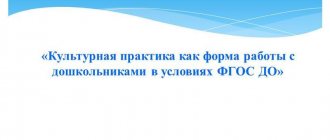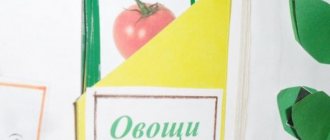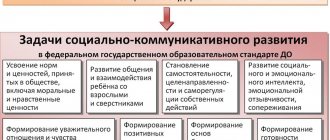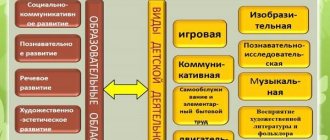INTEGRATION AS A MEANS OF ORGANIZING THE EDUCATIONAL PROCESS IN A PRESCHOOL INSTITUTION
Hello, dear colleagues, allow me to present to your attention the topic for the “Public Lecture”: INTEGRATION
AS A MEANS OF ORGANIZING THE EDUCATIONAL PROCESS IN A PRESCHOOL INSTITUTION
Preschool age is characterized by many psychologists as containing great unrealized opportunities in knowledge of the world around us. Educational activities help to reveal them. In the classroom, in joint and independent activities, initiative, creativity, mental abilities, and cognitive interests are successfully developed, which contributes to the process of active acquisition of knowledge. This is only possible if the activity is integrated.
Integration means restoration, replenishment, unification of parts into a whole. An integrated lesson is a specially organized lesson, the goal of which can be achieved only by combining knowledge from different educational fields, allowing students to achieve a holistic perception of the issue under study, which has a practical orientation.
By building the educational process on the principle of integration of educational areas, we solve such problems as:
- Formation of deeper, more versatile knowledge in children; a holistic view of the world. The world surrounding children is known by them in its diversity and unity;
- Integration promotes the formation of generalized ideas, knowledge and skills, increases the effectiveness of the upbringing and development of children, encourages them to actively understand the surrounding reality, comprehend and find cause-and-effect relationships, develop logic, thinking, and communication abilities.
In accordance with the Federal State Educational Standard for Educational Education, the main educational program is built taking into account the principle of integration of educational areas in accordance with the age capabilities and characteristics of pupils, the specifics and capabilities of educational areas and is based on a comprehensive thematic principle of constructing the educational process, which provides the preschooler with a holistic perception of the world around him.
The content of psychological and pedagogical work on children's mastery of educational fields is focused on the development of children's physical, intellectual and personal qualities. The tasks of psychological and pedagogical work on the formation of physical, intellectual and personal qualities of children are solved integrated in the course of mastering all educational areas, along with tasks reflecting the specifics of each educational area, with mandatory psychological support.
The first system-forming factor in preschool education is educational areas. The Federal State Educational Standard identifies 5 educational areas that should not be implemented in the educational activities of kindergartens in their pure form; their implementation presupposes harmonious interpenetration and complementarity.
Each educational area is aimed at developing some activity:
- “Physical development” - motor activity;
- “Social and communicative development” - gaming activity;
- “Cognitive development” - cognitive and research activities;
- “Speech development” - communicative activity;
- “Artistic and aesthetic development” is a productive activity.
The second system-forming factor is their integration on the basis of calendar-thematic planning: the choice of a specific topic also determines the selection of educational areas for it that will comprehensively reveal its content to the child.
Taking into account the Federal State Educational Standard, we determine that educational activities are carried out in the process of organizing various types of children's activities, as well as during regime moments, in the independent activities of children and in interaction with the families of pupils.
Integration of content allows you to create a model for organizing the pedagogical process, where the child comprehends basic categories (part, whole, etc.) from different points of view, in different educational fields. In pedagogical science, integration is considered as the leading form of organizing the content of education.
The principle of integration has a psychological basis associated with the age characteristics of preschoolers: “grasping” the whole before the parts allows the child to see objects integrally. An integrated approach makes it possible to develop in unity the cognitive, emotional and practical spheres of the child’s personality. An integrated approach to educational activities corresponds to one of the main requirements of preschool didactics: education should be small in volume, but capacious.
The essence of an integrated approach to educational activities is the combination of knowledge from different fields on an equal basis, complementing each other. At the same time, during the lesson, teachers have the opportunity to solve several problems from various areas of the program, and children master the content through the main types of children's activities: cognitive-research, labor, artistic-creative, communicative, motor. Within the framework of an integrated approach, children consider this or that phenomenon or event from different angles, highlighting and studying different aspects: social, including moral and ethical; emotional and sensual, including musical, artistic and aesthetic; logical-mathematical; natural sciences
For example, when planning and conducting educational activities on cognitive and speech development, I, as a teacher, use methods such as:
- surprise, game moments;
- examination, observation, comparison, examination;
- comparative analysis, comparison, partial search activity
- problematic questions that stimulate the manifestation of a kind of joint “discovery” with the teacher, helping the child find the answer;
- a variety of speech didactic games to activate the vocabulary. The form of the GCD is non-standard, interesting, it can be exciting trips, educational and virtual excursions, interesting meetings.
In connection with the implementation of the federal state standard, play becomes the content and form of organization of children’s lives. I include play moments, situations and techniques in all types of children’s activities and communication. I fill children’s daily lives with interesting activities, games, problems, ideas, include each child in meaningful activities, and contribute to the realization of children’s interests and life activity.
Teaching children structure as an exciting problem-based game activity that ensures the child’s subjective position and the constant growth of his independence and creativity. In constructing the pedagogical process, I mainly use a visual and practical method and a way of organizing activities: observations, excursions, elementary experiments, experimentation, game problem situations, etc.
As a teacher, I use all the variety of forms of working with children to solve pedagogical problems, but at every moment I think through specific organizational situations. The qualitative result of educational activities depends not only on the program, but primarily on the personality of the teacher, who creates an emotionally rich environment for the child to master a particular area of knowledge (regime moments, independent children's activities). I solve problems related to the formation of physical, intellectual and personal qualities of children in the course of mastering all educational areas in an integrated manner.
The use of the project method in preschool organizations is one of the methods of integrated education for preschoolers.
A project is a set of actions specially organized by an adult and carried out by children, culminating in the creation of creative works.
The project method describes a set of actions of a child and methods (techniques) for a teacher to organize these actions, that is, it is a pedagogical technology. Using this method in the educational process helps you learn to work in a team, and develop your own algorithm of actions to achieve your goal. The choice of a specific project topic also determines the selection of educational areas for it that will comprehensively reveal its content to the child. For example, the project “Green onions for all ailments”, “March 8 – Mother’s Day”, implemented by me in the group.
For preschoolers, educational work is based on material that is close and understandable to children, maximally covering the range of phenomena that they encounter.
The peculiarity of organizing an integrated process in a preschool educational institution is that all of the listed forms cannot exist in their pure form; the choice of a specific topic also presupposes their integration. The study of some topics takes place as a project activity.
For example, the theme “Day of Defenders of the Fatherland” determines the choice of such educational areas as “Social and communicative development”, “Cognitive development”, “Speech development”, “Artistic and aesthetic development”, “Physical development”, as well as types of activities: artistic- creative, gaming, reading, cognitive-research, motor. During the week, children are read works about the Russian army, look at reproductions of paintings about the army, an exhibition and a collage about the army are being prepared, I show presentations on military topics, and introduce them to military professions. During educational classes they talk about the army, get acquainted with the types of troops, military uniforms, equipment, play various speech games, make up a story based on a series of paintings, make a gift for dad - an applique postcard, listen to musical works dedicated to the army (military march), the United The organizational form can be a complex educational and musical themed lesson (entertainment), a sports festival held together with parents (fathers).
The technology for integrating organized educational activities may be different, but in any case it is necessary to demonstrate the creative activity of the teacher. This is one of the important conditions for its implementation for the development of children's abilities, taking into account the thematic event with the implementation of the national regional component.
Model “Integration (combination) of academic disciplines”
The natural science picture of the world unites the subject systems of physics, chemistry, geography, and biology. For its effective formation, there are attempts to create combined courses: physics and chemistry; geography, biology and chemistry (natural science); history, literature, music and fine arts (world artistic culture); mathematics and labor (mathematics and design), “Mathematics and design”, “Natural history and agriculture”, “Physics with the fundamentals of industrial production”, “Fine arts and artistic work”, etc.
For some specialized educational institutions, the state education standard provides for an integrated course “Fundamentals of natural science knowledge of the world,” combining such disciplines as mathematics, physics, chemistry and biology, which are studied in the final grades of secondary schools. The purpose of this integrated course is not only to teach students the named disciplines (even if in an abbreviated version), but also to process the material of these subjects in such a way that they represent a discipline in which various branches of science are united among themselves on a single logical basis.
Integrated activities (lessons). The construction of the educational process on an integral basis is embodied not only by integrated disciplines. Integrated lessons, which have become widespread in recent years, are most often a form of generalization of knowledge. They can be conducted on the basis of intra-subject, inter-subject and inter-system integration: combined two-, three- and four-subject, immersion lesson, excursion lesson, hiking lesson, travel lesson, etc.
Integrated lessons often serve as a direct consequence of the parallel study of related subjects (topics), which are, as it were, carried out in one lesson.
This achieves:
- actual unification of subject knowledge systems about a given object, phenomenon;
- gain in time spent on mastering the material;
— one of the teachers has freed up time for individual work, supervision, etc.
Examples: integrated lesson “Crystals” (physics + chemistry), lesson “Geographical discoveries” (geography + history).
Integrated days. On this day, lessons in physics, chemistry, and biology are taught one after another and taught almost simultaneously by three teachers. Example: “Forces in nature, their manifestation in animal and human organisms.” At the same time, there is no delayed integration of natural science knowledge acquired in the lessons of various subjects.
Preparation for the implementation of each such integrated model begins 2-3 weeks in advance. Interdisciplinary consultations are held in advance, where students are advised how much work needs to be completed immediately before the “day”.




